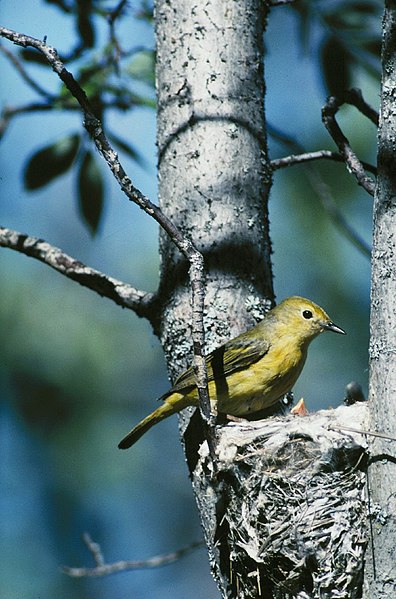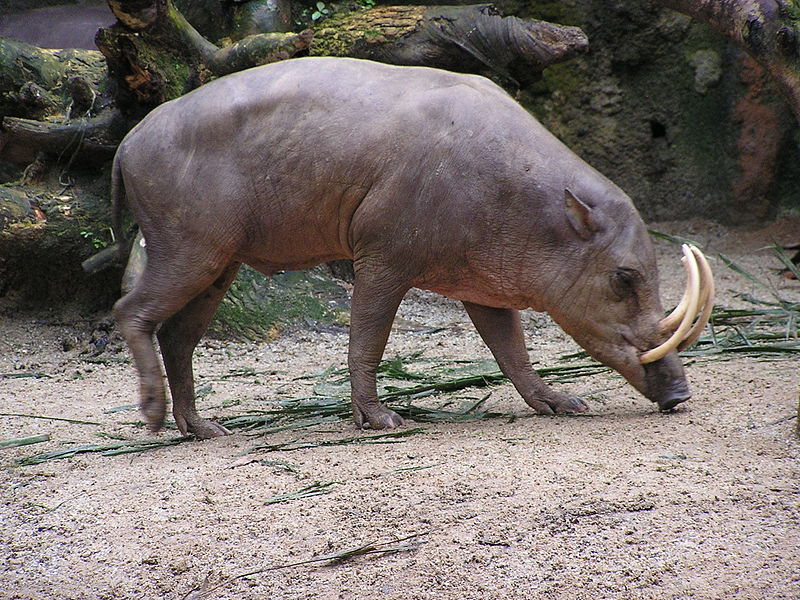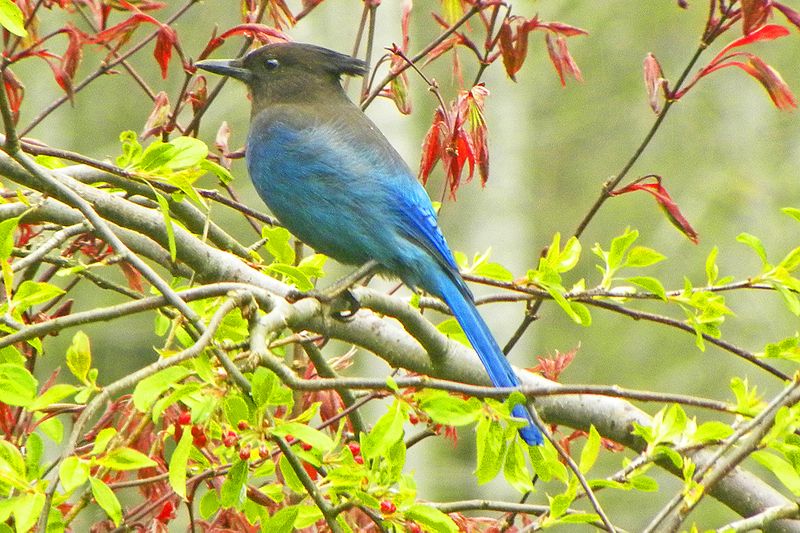I’ve been writing quite a bit about the trade in wild-caught African Gray Parrots in recent weeks. In stark contrast to most countries inhabited by parrots, several African nations still allow the capture and sale of wild birds. In others, lax enforcement renders existing laws useless. There has, however, been a recent spate of confiscations in Africa, but not all have turned out well….in one instance, government officials of the Democratic Republic of Congo actually returned hundreds of illegally collected parrots to poachers (please see article below)! Today I’ll highlight some good that may have come from a particularly sad situation. Read More »
Category Archives: Wild Birds
Feed SubscriptionFive Ways to Welcome Migratory Birds Back to Your Yard
 Birds all across the USA are now returning from their wintering grounds and will soon be visiting feeders and raising new families. Many migratory birds are threatened by loss of both summer and winter habitats, and by problems they encounter on route. Anything we can do to help migratory birds will also benefit resident species, and of course will enable us to more easily observe and enjoy them. Please consider the following suggestions.
Birds all across the USA are now returning from their wintering grounds and will soon be visiting feeders and raising new families. Many migratory birds are threatened by loss of both summer and winter habitats, and by problems they encounter on route. Anything we can do to help migratory birds will also benefit resident species, and of course will enable us to more easily observe and enjoy them. Please consider the following suggestions.
Native Vegetation and Dead Trees
Allow a portion of your yard to “remain wild” by encouraging native scrub, bushes and grasses. If you also have a garden and/or lawn, adding native plants will create an “edge effect” – a zone where different habits meet. Such areas, whether they be forest/field or lawn/scrub, always attract far more species than either habitat individually. Read More »
The Ornate Lorikeet – the World’s Most Colorful Parrot? – Part 1
 “Most colorful” is a tough title to clench in the parrot world. The Ornate Lorikeet, Trichoglossus ornatus, however, must surely be a top contender. In fact, the name “ornate” does it little justice, as would any description of its plumage. No longer commonly kept in the USA, this is a bird worth searching for in zoos or among large private collections.
“Most colorful” is a tough title to clench in the parrot world. The Ornate Lorikeet, Trichoglossus ornatus, however, must surely be a top contender. In fact, the name “ornate” does it little justice, as would any description of its plumage. No longer commonly kept in the USA, this is a bird worth searching for in zoos or among large private collections.
Description
The Ornate Lorikeet’s feathers span the rainbow – most are bright green edged in yellow, deep blue or brilliant red edged in dark blue, but there are other colors as well. The eyes are orange and the beak is a “screaming” orange-red. It’s hard to imagine all the color that is packed into its 10-inch-long body (please see photo)!
Range and Habitat
Indonesian island of Sulawesi, just east of Borneo, is home to an incredible array of animal “standouts” – black, ape-like monkeys, giant gliding possums and babirusas (odd pigs sporting tusks that grow right their skin, please see photo), to name just a few. So it seems fitting that a bird so uniquely-colored as the Ornate Lorikeet is found here, and on a few offshore islands, and nowhere else on earth.
Ornate Lorikeets favor mountain forest edges and overgrown scrub, and also frequent villages bordered by dense cover (imagine having these fellows as feeder visitors!). They are most commonly seen in pairs or small flocks and feed upon flower blossoms, nectar, pollen, fruit and some greens; insects may be taken as well, but field studies are lacking.
Captive History
 I recall caring for Ornate Lorikeets when working for a bird importer as a teenager, but they are not at all common in the USA today. They have a reputation for being quite delicate as regards temperature, and even long term captive seem prone to respiratory and digestive system distress. When in the peak of good health, their voices are as loud, and far harsher, than are their colors!
I recall caring for Ornate Lorikeets when working for a bird importer as a teenager, but they are not at all common in the USA today. They have a reputation for being quite delicate as regards temperature, and even long term captive seem prone to respiratory and digestive system distress. When in the peak of good health, their voices are as loud, and far harsher, than are their colors!
On to diet and general care in Part 2.
Further Reading
Volunteer Bird Surveys – Results, Trends and Surprises
 Volunteer participants in Project Feederwatch, the Audubon Society Christmas Bird Count and similar efforts have been providing ornithologists with much-needed data for decades. It’s simple to get involved, and there’s still time to help out in this winter’s programs (please see article below). Today I’d like to summarize some results from both this winter and last.
Volunteer participants in Project Feederwatch, the Audubon Society Christmas Bird Count and similar efforts have been providing ornithologists with much-needed data for decades. It’s simple to get involved, and there’s still time to help out in this winter’s programs (please see article below). Today I’d like to summarize some results from both this winter and last.
Project Feederwatch
Overseen by the Cornell Laboratory of Ornithology and several Canadian organizations, Project Feederwatch attracted 15,699 participants last winter (2009-2010). Altogether, 112,590 lists, documenting a staggering 5,855,881 individual birds, were submitted.
California and the Southwest
Pine Siskins, Pine Grosbeaks and Redpolls, which often move as winter arrives, were quite scarce; this was likely due to the availability of food in Canada.
Leading all species in the region’s counts were House Finches, Dark-Eyed Juncos, Mourning Doves, Western Scrub Jays and White-Crowned Sparrows. Steller’s Jays and Cooper’s and Sharp-Shinned Hawks (both of which visit feeders in search of prey) were less in evidence than usual.
Lesser Goldfinches, Ruby-Crowned Kinglets and introduced Eurasian Collared Doves were seen in near-record numbers, while populations of Golden-Crowned Sparrows, Pine Siskins and Purple Finches seem to have declined.
The Northeast
Chickadees, Mourning Doves, Dark-Eyed Juncos, Downy Woodpeckers and Blue Jays maintained their traditional “top 5” status, but all were seen in less-than-expected numbers.
Brown-Headed Cowbirds and Purple Finches were not abundant, and Redpolls were nearly absent. On a positive note, Northern Flickers, Chipping Sparrows, and Eastern Bluebirds seem to be on the increase. The introduced Eurasian Collared Dove continues to expand its range.
Please see the report below for summaries of counts held in other parts of the USA and Canada.
New York State
 I hope you’ll pardon my emphasis on my home state… While NYC may not seem ideal bird-counting territory, the grounds of the Bronx Zoo, Central Park and other hotspots have yielded over 250 species each. Having haunted such places since childhood, I’ve seen a good many, including such notables as Long-Eared Owls and Bald Eagles.
I hope you’ll pardon my emphasis on my home state… While NYC may not seem ideal bird-counting territory, the grounds of the Bronx Zoo, Central Park and other hotspots have yielded over 250 species each. Having haunted such places since childhood, I’ve seen a good many, including such notables as Long-Eared Owls and Bald Eagles.
The frigid environs of Albany would seem as forbidding to birds as does the Bronx, but here again there were many surprises. The NYS Department of Environmental Conservation’s New Year’s Day Count revealed range expansions for Tufted Titmice and Northern Cardinals, both of which were absent from the region 50 years ago. Red-backed Woodpeckers and Yellow-Bellied Sapsuckers, first observed in 1989 and 2008, respectively, seem to be there to stay.
Volunteer bird-watchers amass reams of data that could not be gathered b any other means…and all of it is used by ornithologists to track the health of native bird populations.
Further Reading
How Birders can Contribute to Conservation
Video: Cooper’s Hawk on patrol at bird feeder
Steller’s Jay image referenced from wikipedia and originally posted by Jerry Keenan
Feeding Finches – Tips and Special Considerations – Part 1
Many popular finches will live for years on relatively simple diets composed of a few types of seed. However, studies of wild finches have revealed that most consume a wide range of other foods. The following suggestions will help you to maintain your finches in peak health, color and breeding condition… a bit more work than simply filling a feed cup with seeds each day, but well-worthwhile. Read More »
 That Bird Blog – Bird Care and History for Pet Birds
That Bird Blog – Bird Care and History for Pet Birds

